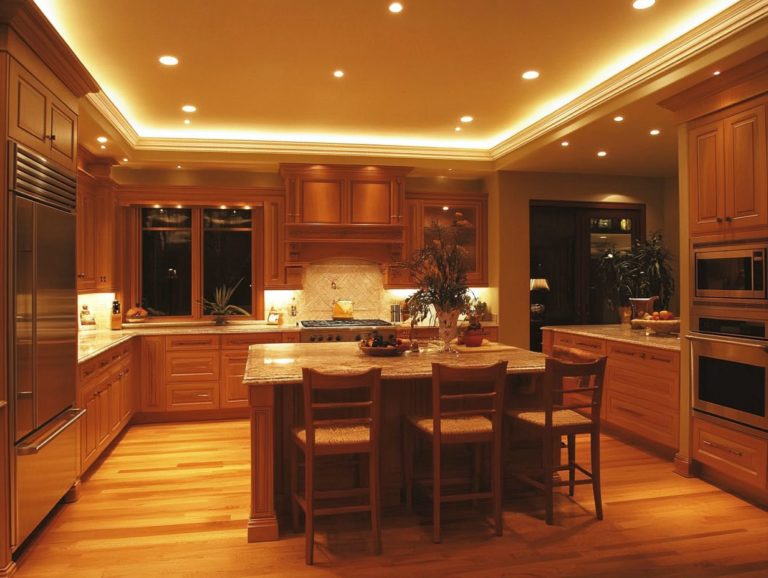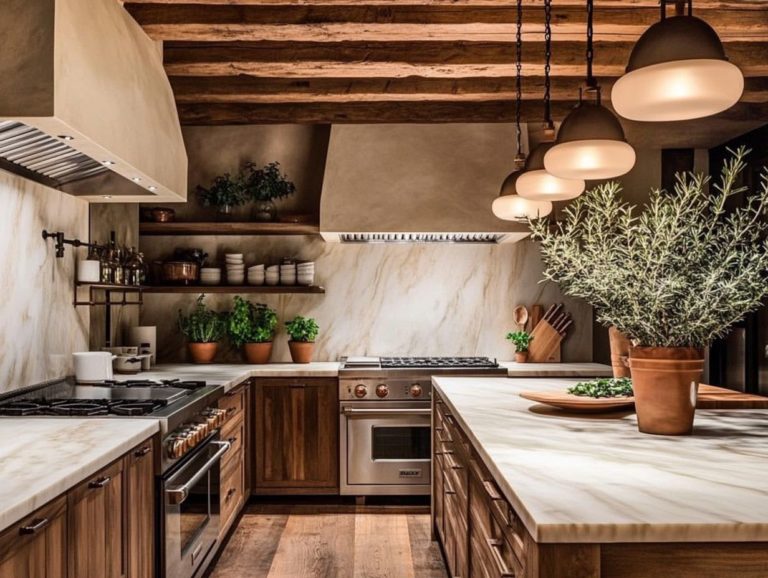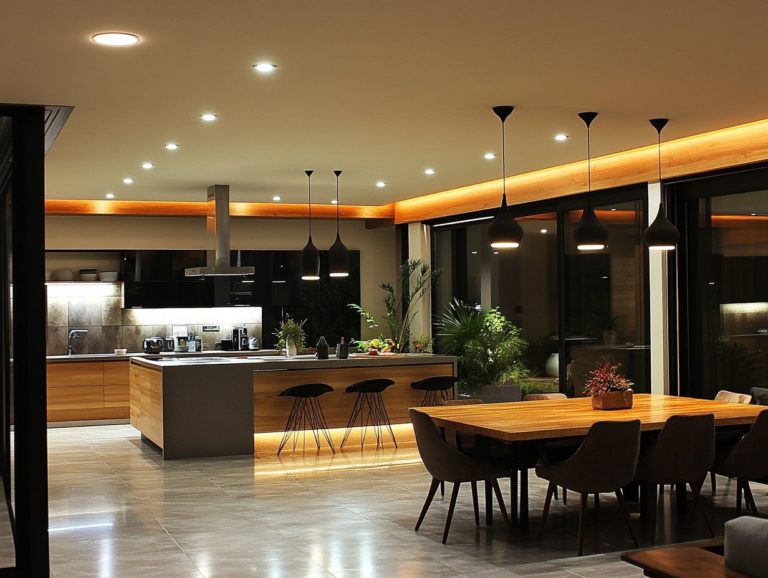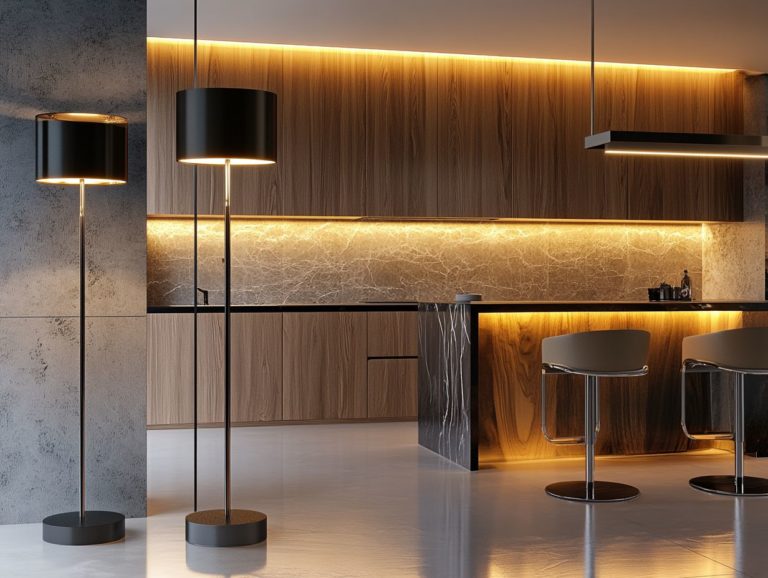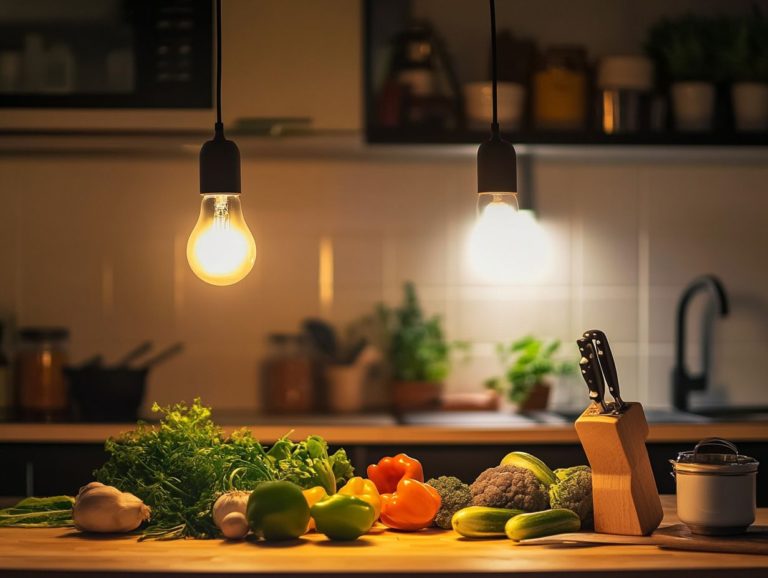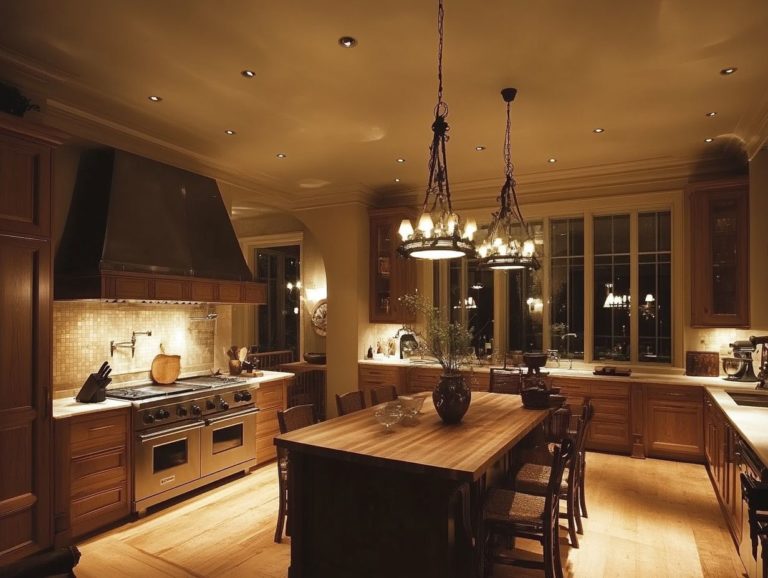Choosing the Best Lightbulbs for Kitchen Fixtures
Proper lighting can elevate your kitchen from a simple workspace to a vibrant cooking space.
By selecting the right lightbulbs, you can enhance functionality and create the perfect ambiance for both cooking and entertaining.
This article delves into various types of lightbulbs—incandescent, LED, and CFL—while highlighting the essential factors to consider in your decision-making process.
You’ll also find valuable insights on the best bulbs for different fixtures, along with practical tips for installation and maintenance.
Light up your kitchen and let your creativity shine!
Contents
- Key Takeaways:
- Types of Lightbulbs
- Factors to Consider When Choosing Lightbulbs for Kitchen Fixtures
- Best Lightbulbs for Different Kitchen Fixtures
- Tips for Installing Lightbulbs in Kitchen Fixtures
- Frequently Asked Questions
- Want to know what factors to consider when choosing the best lightbulbs for my kitchen fixtures?
- What types of lightbulbs are best for kitchen fixtures?
- How can I determine the appropriate brightness for my kitchen lightbulbs?
- What is color temperature and why is it important when choosing lightbulbs for kitchen fixtures?
- Are there any energy-efficient options for lightbulbs in kitchen fixtures?
- Can I mix different types of lightbulbs in my kitchen fixtures?
Key Takeaways:
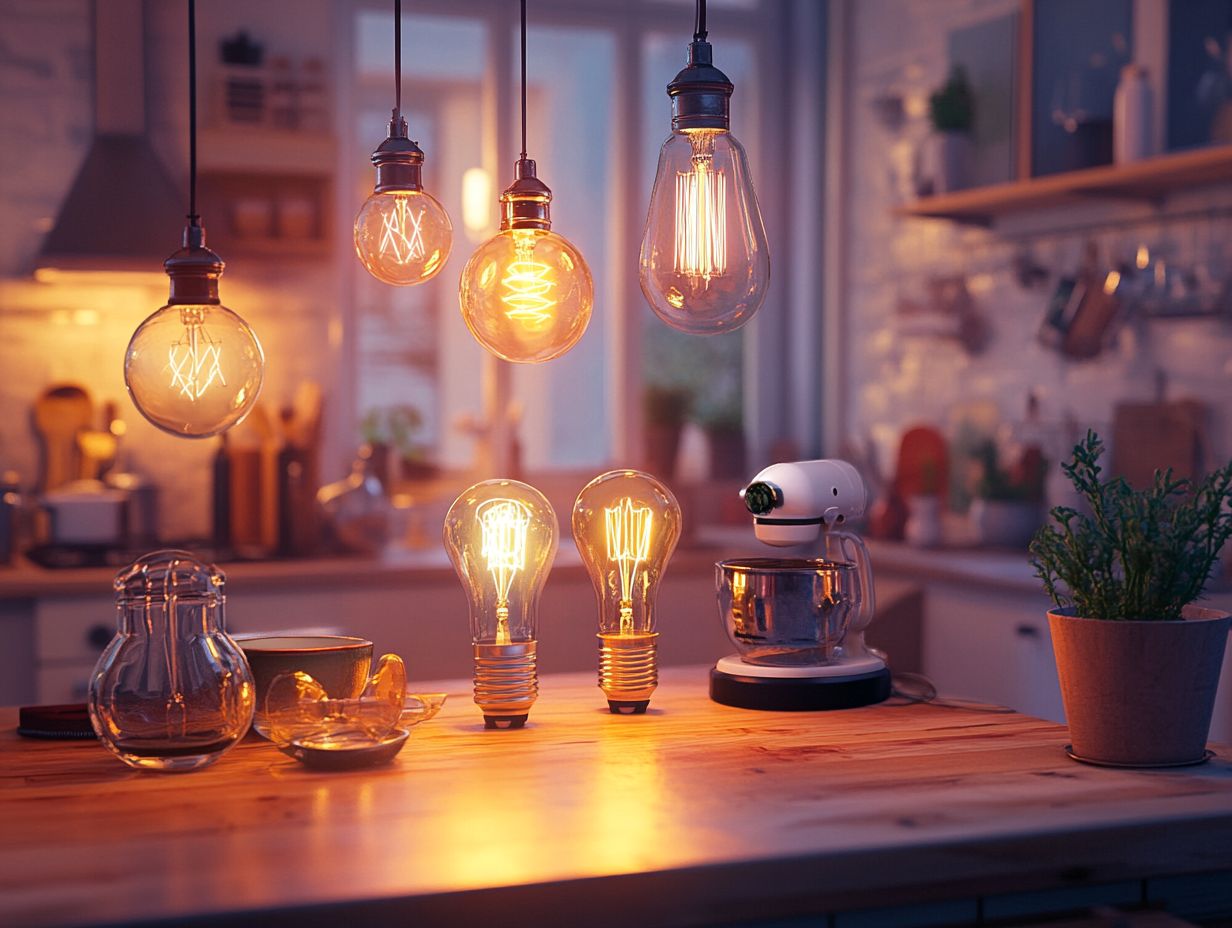
Proper lighting transforms your kitchen into a functional and inviting space. When choosing bulbs, think about wattage, color, and energy use. Opt for LED for overhead lights, CFL for under-cabinet fixtures, and always follow proper installation tips for the best results.
The Importance of Proper Lighting in the Kitchen
Proper lighting in your kitchen is essential for enhancing functionality, creating a captivating ambiance, and ensuring energy efficiency.
It significantly influences how you navigate the space for both cooking and socializing. With the right lighting options, you can elevate your kitchen design while ensuring that every task is performed with clarity and comfort.
Incorporating task lighting, like under-cabinet fixtures, provides direct illumination for food preparation activities, making chopping, slicing, and mixing safer and more efficient.
Ambient lighting sets the mood for gatherings, transforming your kitchen into a welcoming social hub.
Opting for bulb types such as LEDs extends the lifespan of your lighting and lowers energy consumption, saving you money on electricity bills and reducing the hassle of frequent replacements.
You can blend various lighting styles to create visually appealing layers that enhance both the aesthetics and functionality of your culinary space.
Types of Lightbulbs
The array of light bulbs available today—incandescent, LED, CFL, fluorescent, and halogen—provides you with numerous options for illuminating your spaces with precision and style.
Each type of bulb boasts its unique characteristics, advantages, and applications, enabling you to select the ideal light source for every room in your home.
With cutting-edge innovations like smart bulbs, enhancing your lighting experience is effortless and elevates both functionality and aesthetic appeal.
Incandescent, LED, and CFL Bulbs
Incandescent, LED, and CFL bulbs are three popular options for your home lighting, each boasting features and benefits that cater to your specific preferences and needs.
People love incandescent bulbs for their warm glow. LED bulbs have gained acclaim for their remarkable energy efficiency and long lifespan, making them a savvy choice for cutting down on energy costs.
CFLs provide decent energy savings along with a range of color temperature ratings to suit your various lighting needs.
When weighing the pros and cons, consider the lifespan of each bulb type. Incandescents typically last about 1,000 hours, while LEDs shine brightly for over 25,000 hours.
Energy efficiency is another major consideration: LED bulbs consume significantly less wattage, allowing you to bask in vibrant brightness without the shock of inflated electricity bills.
CFLs offer a respectable lifespan of around 10,000 hours, although they may not achieve the same brightness levels as their incandescent and LED counterparts.
Ultimately, your preferences may lean toward the nostalgic warmth of incandescent bulbs or the cutting-edge efficiency of LEDs, depending on your individual lighting needs and aesthetic aspirations.
Don’t wait! Upgrade your bulbs today and transform your kitchen lighting!
Start your lighting project now and watch your kitchen transform!
Factors to Consider When Choosing Lightbulbs for Kitchen Fixtures
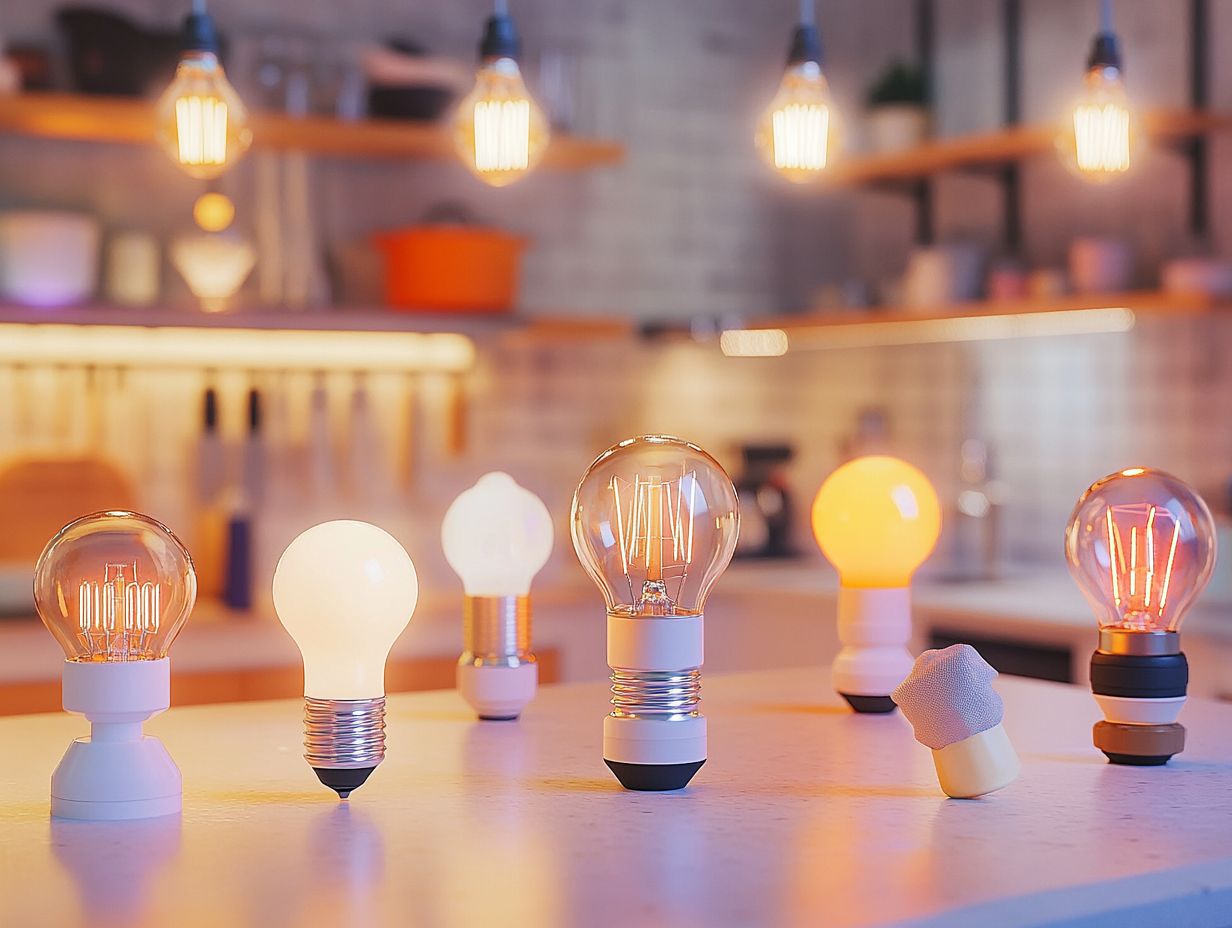
Selecting the perfect lightbulbs for your kitchen fixtures entails several crucial considerations. These include wattage, color temperature, and energy efficiency.
Each of these factors plays a vital role in creating a well-illuminated space that meets your practical needs while reflecting your aesthetic taste.
Understanding bulb characteristics, such as lumens and fitting types, can elevate your kitchen experience. This ensures that the lighting not only enhances your design but also contributes to long-term energy savings.
Wattage, Color Temperature, and Energy Efficiency
When selecting lightbulbs for your kitchen, it’s essential to understand wattage, color temperature, and energy efficiency to achieve the perfect lighting.
Wattage measures the energy consumption of bulbs, while lumens indicate the amount of light a bulb produces. This knowledge helps you choose bulbs that deliver the illumination you desire.
Color temperature, which ranges from warm white to cool white, influences the overall mood and functionality of your kitchen space.
To strike the right balance between ambiance and practicality, consider opting for LED bulbs. They provide a high lumens output with lower wattage, allowing you to cut energy costs without compromising brightness.
A color temperature between 3000K and 4000K is often ideal for kitchens, creating a cozy yet vibrant atmosphere perfect for both cooking and entertaining.
Adding dimmer switches enhances flexibility, enabling you to adjust the lighting based on the time of day or specific tasks at hand.
By balancing these factors, you ensure an energy-efficient lighting scheme that meets both your aesthetic aspirations and functional needs.
Best Lightbulbs for Different Kitchen Fixtures
Choosing the right lightbulbs for your kitchen fixtures—whether for overhead lights, under-cabinet lights, or task lights—requires an understanding of what each bulb type offers.
The perfect selection depends on the unique lighting requirements of each space, whether you need ambient lighting, focused task illumination, or decorative touches.
By thoughtfully evaluating the purpose of each fixture, you can enhance both the functionality and visual appeal of your kitchen.
Overhead Lights, Under Cabinet Lights, and Task Lights
Overhead lights, under cabinet lights, and task lights each serve distinct purposes in your kitchen design. Attention to bulb characteristics and shapes is crucial for the best results.
These lighting types are essential in creating an inviting yet functional atmosphere. Overhead lights, often wide and diffused, provide the overall brightness necessary for cooking and entertaining. Choosing bulbs that emit warm tones creates a cozy setting, perfect for family gatherings.
Under cabinet lights, typically linear in shape, effectively illuminate your countertops, ensuring that no shadowy corners jeopardize safety during food prep.
Task lights, featuring focused beams, are ideal for sinks or cutting boards, enabling you to tackle intricate cooking tasks with precision.
By prioritizing energy-efficient options, you can reduce electricity bills and contribute to sustainable home practices, ensuring that the vibrant heart of your home remains both efficient and eco-friendly.
Tips for Installing Lightbulbs in Kitchen Fixtures
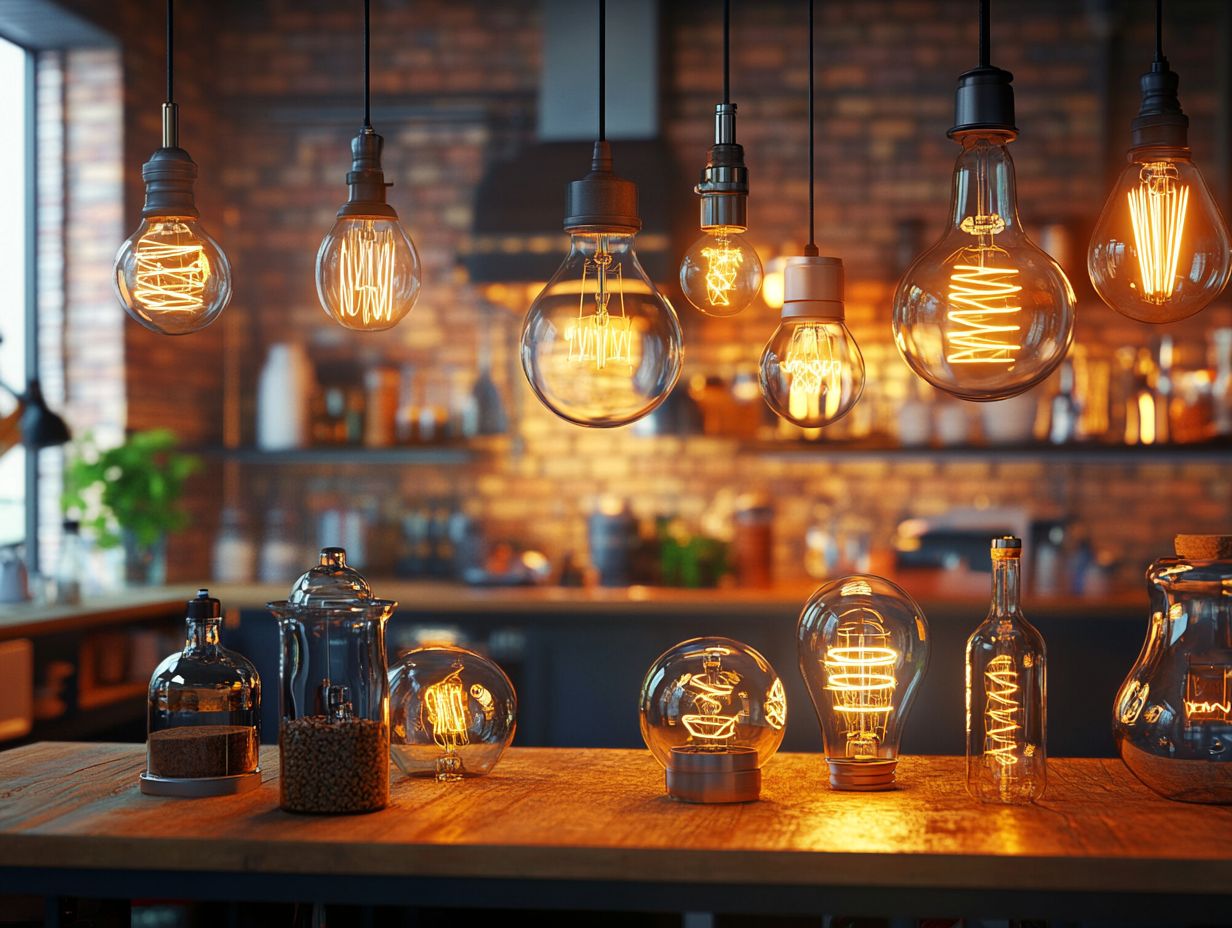
Installing lightbulbs in your kitchen fixtures can be a fun and rewarding experience! It requires attention to detail for optimal functionality and longevity.
By mastering the correct placement of each bulb, you enhance energy efficiency, reduce costs, and prolong the lifespan of your bulbs.
With the right techniques and diligent maintenance practices, transform your kitchen lighting today for a brighter and more inviting space!
Proper Placement and Maintenance
Proper placement and maintenance of lightbulbs are essential for maximizing their effectiveness and lifespan in your kitchen. By strategically positioning bulbs to ensure optimal light usage, you can elevate the functionality of your space while keeping energy costs in check.
Regular maintenance practices, like cleaning fixtures and replacing bulbs as needed, will extend the life of your lighting solutions. Make it a habit to inspect bulbs regularly for flickering or dimming, as these can be early indications that replacement is needed.
Selecting the right type of bulb for various areas is key. Consider:
- Bright white LEDs for workspaces
- Softer tones for dining areas
This will significantly enhance both the aesthetics and usability of your kitchen. It’s smart to incorporate dimmer switches where appropriate, allowing you to adjust lighting levels based on the task at hand. Adjusting lighting levels can create the perfect vibe and lower your energy bills!
Keeping lamps and fixtures dust-free will ensure your kitchen remains brightly lit and inviting, further enhancing both safety and efficiency.
Frequently Asked Questions
Want to know what factors to consider when choosing the best lightbulbs for my kitchen fixtures?
When choosing the best lightbulbs for your kitchen fixtures, you should consider brightness, color temperature, energy efficiency, and compatibility with your fixtures. Consider the type of lighting you need for different areas of your kitchen, such as task lighting for cooking and ambient lighting for dining or entertaining.
What types of lightbulbs are best for kitchen fixtures?
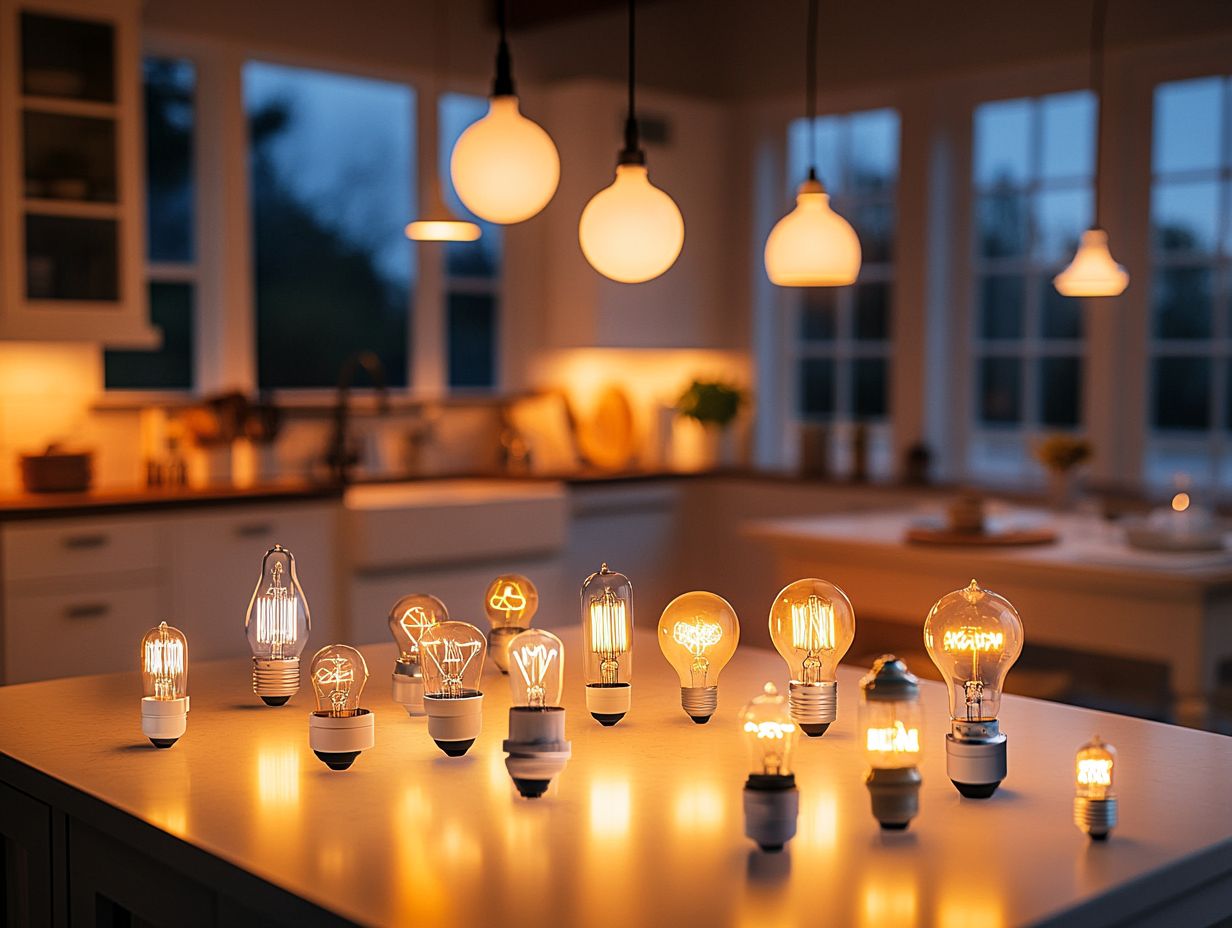
The most common types of lightbulbs used for kitchen fixtures are LED, CFL, and halogen. LED bulbs are the most energy-efficient and long-lasting, while CFL bulbs are affordable and emit a warm, natural light. Halogen bulbs provide a bright, white light and are often used as spotlights in kitchens.
How can I determine the appropriate brightness for my kitchen lightbulbs?
The recommended brightness for kitchen lightbulbs depends on the size of your kitchen and the type of lighting you need. Generally, for a small kitchen, 5-10 watts per square foot is sufficient for ambient lighting, while task lighting may require 50-75 watts per square foot. For larger kitchens, aim for higher wattages to ensure proper lighting.
What is color temperature and why is it important when choosing lightbulbs for kitchen fixtures?
Color temperature refers to how warm or cool the light looks. In kitchens, it is important to choose a color temperature that is bright enough for tasks but not too harsh. For a warm and inviting atmosphere, opt for bulbs with a color temperature of 2700-3000K. For a brighter and more vibrant space, choose bulbs with a color temperature of 4000-5000K.
Are there any energy-efficient options for lightbulbs in kitchen fixtures?
Yes, LED and CFL bulbs are both energy-efficient options for kitchen fixtures. LED bulbs use 75-80% less energy than traditional incandescent bulbs and can last up to 25,000 hours. CFL bulbs use 75% less energy and can last up to 10,000 hours. While these bulbs may be initially more expensive, they will save you money on your energy bills in the long run.
Can I mix different types of lightbulbs in my kitchen fixtures?
Yes, it is possible to mix different types of lightbulbs in your kitchen fixtures to create a layered and versatile lighting scheme. For example, you can use LED bulbs for general lighting, CFL bulbs for task lighting, and halogen bulbs for accent lighting. Just ensure that the bulbs are compatible with your fixtures and that the color temperatures are similar for a cohesive look.
